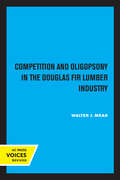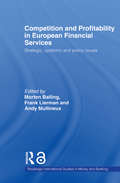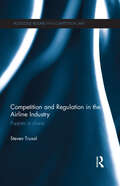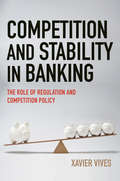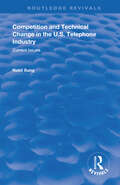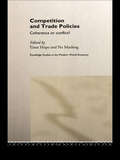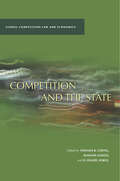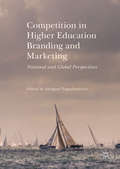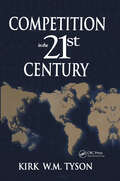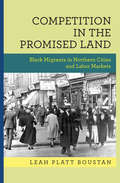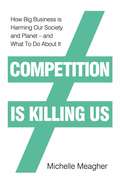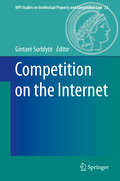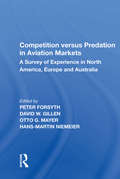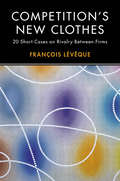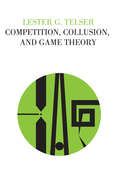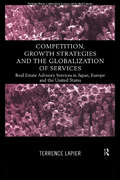- Table View
- List View
Competition and Oligopsony in the Douglas Fir Lumber Industry
by Walter J. MeadThis title is part of UC Press's Voices Revived program, which commemorates University of California Press’s mission to seek out and cultivate the brightest minds and give them voice, reach, and impact. Drawing on a backlist dating to 1893, Voices Revived makes high-quality, peer-reviewed scholarship accessible once again using print-on-demand technology. This title was originally published in 1966.
Competition and Profitability in European Financial Services: Strategic, Systemic and Policy Issues (Routledge International Studies in Money and Banking #Vol. 33)
by Andy Mullineux Morten Balling Frank LiermanFinancial services firms play a key role in the European economy. The efficiency and profitability of these firms and the competition among them have an impact on allocation of savings, financing of investment, economic growth, the stability of the financial system and the transmission of monetary policy. This collection of research contributions includes evaluations of trends in the European financial service industry and examinations of the driving forces of efficiency, competition and profitability of financial firms and institutions in Europe. The papers have been written by leading academics and researchers in the field, who specialize in strategic, systematic and policy issues related to the European financial services industry. This edited collection will be will be essential reading for students and academics but will also be of interest to financial practitioners and government officials interested in acquiring a deeper understanding of this complex issue.
Competition and Regulation in the Airline Industry: Puppets in Chaos (Routledge Research in Competition Law)
by Steven TruxalAn examination of the relationship between competition and the deregulation and liberalisation of the US and European air transport sectors reveals that the structure of the air transport sector has undergone a number of significant changes. A growing number of airlines are entering into horizontal and vertical cooperative arrangements and integration including franchising, codeshare agreements, alliances, ‘virtual mergers’ and in some cases, mergers with other airlines, groups of airlines or other complementary lines of business such as airports. This book considers the current legal issues affecting the air transport sector incorporating recent developments in the industry, including the end of certain exemptions from EU competition rules, the effect of the EU-US Open Skies Agreement, the accession of new EU Member States and the Lisbon Treaty. The book explores the differing European and US regulatory approaches to the changes in the industry and examines how airlines have remained economically efficient in what is perceived as a complex and confused regulatory environment. Competition and Regulation in the Airline Industry will be of particular interest to academics and students of competition law as well as EU law.
Competition and Stability in Banking: The Role of Regulation and Competition Policy
by Xavier VivesDoes too much competition in banking hurt society? What policies can best protect and stabilize banking without stifling it? Institutional responses to such questions have evolved over time, from interventionist regulatory control after the Great Depression to the liberalization policies that started in the United States in the 1970s. The global financial crisis of 2007-2009, which originated from an oversupply of credit, once again raised questions about excessive banking competition and what should be done about it. Competition and Stability in Banking addresses the critical relationships between competition, regulation, and stability, and the implications of coordinating banking regulations with competition policies.Xavier Vives argues that while competition is not responsible for fragility in banking, there are trade-offs between competition and stability. Well-designed regulations would alleviate these trade-offs but not eliminate them, and the specificity of competition in banking should be accounted for. Vives argues that regulation and competition policy should be coordinated, with tighter prudential requirements in more competitive situations, but he also shows that supervisory and competition authorities should stand separate from each other, each pursuing its own objective. Vives reviews the theory and empirics of banking competition, drawing on up-to-date analysis that incorporates the characteristics of modern market-based banking, and he looks at regulation, competition policies, and crisis interventions in Europe and the United States, as well as in emerging economies. Focusing on why banking competition policies are necessary, Competition and Stability in Banking examines regulation's impact on the industry's efficiency and effectiveness.
Competition and Techincal Change in the U.S. Telephone Industry
by Nakil SungFirst published in 1997. While local telephone companies still maintain their monopolistic position, rapid technological advance in telecommunications is destroying the established market structure in the local telephone industry. The U.S. Telecommunications Act of 1996 aimed at eliminating any legal barrier which has suppressed technically feasible local competition. This study attempts to provide pro-competitive evidence on the technological or cost structure of the U.S. local telephone industry. In particular, the study presents strong evidence against cost subadditivity of local telephone companies and shows that local telephone companies have been isolated from the disciplinary effects of competition in comparison with their competitive counterparts. The study not only has policy implications for entry and competition in local telephone markets, but also provides a new approach to the measurement of embodied technical change.
Competition and Trade Policies: Coherence or Conflict (Routledge Studies in the Modern World Economy #No.13)
by Einar Hope Per MaelengThe relationship between competition and trade policies, and the development of an effective competition policy for an integrated world economy, is one of the most important and challenging issues policy makers currently face. This book examines the current debates around competition and trade policy interactions, and discusses the need for new policy initiatives in an international context.
Competition and the Corporate Society: British Conservatives, the state and Industry 1945-1964
by Nigel HarrisBritish society changed radically in the 21st century. Any political party dedicated to preserving the Britain of 1900 would have faced, over time, either major problems of adjustment or the possibility of its own destruction. The British Conservative party was just such a party, its character defined by its commitment to the defence of the British status quo. Yet it has also been one of the most successful political parties in the twentieth century. Not only was it able to adjust itself to the transformation of British society including two world wars and the most catastrophic slump – but it was able to win elections more consistently than any of its rivals. This book seeks to show how the Conservatives achieved such a metamorphosis, by identifying the main changes in the British economy and society, and the changing Conservative response. In practice, there was no single Conservative response to any particular change. The debate within the party revealed a surprisingly large number of responses; yet the range was limited. Indeed, with some simplification, one can see only two general political positions, from which flowed differing proposals on all detailed issues. In describing these two positions, the author suggests a new method of classifying dominant political beliefs in Britain and other Western countries. This study covers a wide field, bringing together contemporary Conservative politics, economic problems and economic history. The Conservatives were intimately related to the interests of what used to be called British capitalism, and their attitudes to the changes taking place in industry reveal most clearly the changing political priorities of the party. The book examines Conservative policy, proposals and attitudes to nationalization and the public sector, to the trade unions and labour, to private business and finally to the economic role of the State, between 1945 and 1964. For those wishing to gain an understanding of the British Conservatives, Nigel Harris’ detailed and stimulating material will make excellent reading and has been acclaimed since its first publication in 1972.
Competition and the State
by Ioannis Lianos D. Daniel Sokol Thomas K. ChengCompetition and the State analyzes the role of the state across a number of dimensions as it relates to competition law and policy across a number of dimensions. This book re-conceptualizes the interaction between competition law and government activities in light of the profound transformation of the conception of state action in recent years by looking to the challenges of privatization, new public management, and public-private partnerships. It then asks whether there is a substantive legal framework that might be put in place to address competition issues as they relate to the role of the state. Various chapters also provide case studies of national experiences. The volume also examines one of the most highly controversial policy issues within the competition and regulatory sphere#151;the role of competition law and policy in the financial sector. This book, the third in the Global Competition Law and Economics series, provides a number of viewpoints of what competition law and policy mean both in theory and practice in a development context.
Competition and the State
by Ioannis Lianos D. Daniel Sokol Thomas K. ChengCompetition and the State analyzes the role of the state across a number of dimensions as it relates to competition law and policy across a number of dimensions. This book re-conceptualizes the interaction between competition law and government activities in light of the profound transformation of the conception of state action in recent years by looking to the challenges of privatization, new public management, and public-private partnerships. It then asks whether there is a substantive legal framework that might be put in place to address competition issues as they relate to the role of the state. Various chapters also provide case studies of national experiences. The volume also examines one of the most highly controversial policy issues within the competition and regulatory sphere#151;the role of competition law and policy in the financial sector. This book, the third in the Global Competition Law and Economics series, provides a number of viewpoints of what competition law and policy mean both in theory and practice in a development context.
Competition for Public Transport Services: Institutional Framework and Empirical Evidence of Bus Services in Germany (Contributions to Economics)
by Arne BeckThis book evaluates the successes, failures, and factors that influence the competition for public bus transport services. Using Germany as a case study, the author explains the dichotomous system of a market with licenses for commercial services, where operators are granted exclusivity, and licenses for non-commercial services, where supplementary direct subsidies are tendered out by public transport authorities. The empirical analysis is based on primary data usually not publicly available, and supplemented by numerous expert interviews. The book aims to provide a basic understanding of the players and their options, offer insights into the German model, and make policy recommendations for those whose goal is to increase competition.
Competition in British Industry: Restrictive Practices Legislation in Theory and Practice (Routledge Library Editions: Industrial Economics #2)
by Stewart Howe Dennis Swan Denis P. O'Brien W. Peter MaunderThis book, first published in 1974, presents the findings of a research project and considers their implications for public policy. The project was designed to find out what effect the 1956 Restrictive Trade Practices Act (and the subsequent legislation of 1968) had on British industry. The Act was a decision in favour of competition against a background of well-entrenched and widespread restrictive agreements, and this book examines in depth its impact in eighteen selected industries.
Competition in Higher Education Branding and Marketing: National and Global Perspectives
by Antigoni PapadimitriouThis volume provides a critical examination of branding and marketing in higher education from national, regional, and global perspectives. Contributors with expertise in higher education, sociology, comparative and international education, marketing, rankings, and educational philanthropy use novel theoretical frameworks and cases from Africa, Asia, Europe, Latin America, and the US to map the brandscape of higher education. Empirical cases and literature analysis show that brand building is becoming a deliberate goal for higher education. This book illustrates student-institution dynamics, as well as the critical role of policy and professionalization to support branding and marketing strategies in higher education in relation to equity.
Competition in Theory and Practice (Routledge Library Editions: Industrial Economics #3)
by Terry Burke Angela Genn-Bash Brian HainesWhat is the role of competition in economic activity? How can it be understood? How can it be regulated? Competition is a buzz word in economic policy and in commerce. Yet it is given widely varying roles in different models and is viewed in very different ways by different schools. This book, published in 1991, provides a clear exposition of the major theoretical approaches to competition and an assessment of competition policy in the major economic powers.
Competition in a Consolidating Environment (Zicklin School of Business Financial Markets Series)
by Robert A. Schwartz Antoinette Colaninno John Aidan ByrneCompetition between market centers is a driving force for innovation, dynamic growth, and reasonable pricing structures. Consolidating the order flow amasses liquidity, sharpens price discovery, and lowers trading costs. This book addresses such timely topics as the impact of technology on financial markets and includes contributions from prominent academics, policymakers and professionals in the field. It is the latest title in established conference proceedings series.
Competition in the 21st Century
by Kirk TysonBusiness competition will change radically in the next century. Short-sighted companies will go out of business. Survivors will successfully transition from the so-called Information Age of this century to the Intelligence Age of the 21st Century.Ten years in the making, this book paints competition of the future based on in-depth research of worldwide business over the past 100 years. By analogy, it shows business competition in its 19th-Century childhood, 20th-Century adolescence, and 21st-Century adulthood. The book highlights new beginnings - the Intelligence Age, highly networked "MegaStrategic Business Entities," and the need for both a "Competitive Knowledge Base" and "Perpetual Strategy Process" to provide an early warning system for executives.This is must-reading for business executives, managers and everyday consumers who want to plot a successful course for the future. It is also an invaluable reference tool for educators guiding the business leaders of tomorrow.
Competition in the Financial Sector: Overview of Competition Policies
by Stijn ClaessensA report from the International Monetary Fund.
Competition in the Health Care Sector: Ten Years Later
by Warren Greenberg"Competition. Deregulation. Free market forces. The debate over competition in health care that raged in the 1970s brought with it a new economic jargon, a vocabulary of concepts and issues unheard of in hospitals a decade earlier."Competition in health care has developed to a greater degree than most economists predicted ten years ago. That is the conclusion of Warren Greenberg in his introduction to Competition in the Health Care Sector: Ten Years Later, a retrospective of a 1977 Federal Trade Commission conference, which produced the landmark treatise Competition in the Health Care Sector: Past, Present, and Future. Seven of the ten original papers are reexamined; a chapter on the nursing home industry has been added."As with the original volume, Greenberg predicts that the retrospective will become a critical element in the health care economic literature."--Hospitals
Competition in the Promised Land: Black Migrants in Northern Cities and Labor Markets
by Leah Platt BoustanFrom 1940 to 1970, nearly four million black migrants left the American rural South to settle in the industrial cities of the North and West. Competition in the Promised Land provides a comprehensive account of the long-lasting effects of the influx of black workers on labor markets and urban space in receiving areas.Traditionally, the Great Black Migration has been lauded as a path to general black economic progress. Leah Boustan challenges this view, arguing instead that the migration produced winners and losers within the black community. Boustan shows that migrants themselves gained tremendously, more than doubling their earnings by moving North. But these new arrivals competed with existing black workers, limiting black-white wage convergence in Northern labor markets and slowing black economic growth. Furthermore, many white households responded to the black migration by relocating to the suburbs. White flight was motivated not only by neighborhood racial change but also by the desire on the part of white residents to avoid participating in the local public services and fiscal obligations of increasingly diverse cities. Employing historical census data and state-of-the-art econometric methods, Competition in the Promised Land revises our understanding of the Great Black Migration and its role in the transformation of American society.
Competition is Killing Us: How Big Business is Harming Our Society and Planet - and What To Do About It
by Michelle MeagherWe live in the age of big companies where rising levels of power are concentrated in the hands of a few. Yet no government or organisation has the power to regulate these titans and hold them to account. We need big companies to share their power and we, the people of the world, need to reclaim it. In Competition is Killing Us, top business and competition lawyer Michelle Meagher establishes a new framework to control capitalism from the inside in order to make it work for the many and not just the few. Meagher has spent years campaigning against these multi-billion and trillion dollar mammoths that dominate the market and prioritise shareholder profits over all else; leading to extreme wealth inequality, inhumane conditions for workers and relentless pressure on the environment.In this revolutionary book, she introduces her wholly-achievable alternative; a fair and comprehensive competition law that limits unfair mergers, enforces accountability and redistributes power through stakeholder governance.
Competition on the Internet (MPI Studies on Intellectual Property and Competition Law #23)
by Gintarė SurblytėUndeniably widespread and powerful as it is, the Internet is not almighty: it can reach as high as the skies (cloud computing), but it cannot escape competition. Yet, safeguarding competition in "the network of networks" is not without challenges: not only are competitive processes in platform-based industries complex, so is competition law analysis. The latter is often challenged by the difficulties in predicting the outcome of competition, in particular in terms of innovation. Do the specific competition law issues in a digital environment presuppose a reconsideration of competition law concepts and their application? Can current competition law tools be adjusted to the rush pace of dynamic industries? To what extent could competition law be supplemented by regulation - is the latter a foe or rather an ally? This book provides an analysis of recent developments in the most relevant competition law cases in a digital environment on both sides of the Atlantic (the EU and the US) and assesses platform competition issues from a legal as well as an economic point of view.
Competition versus Predation in Aviation Markets: A Survey of Experience in North America, Europe and Australia (Ashgate Studies In Aviation Economics And Management Ser.)
by Peter ForsythPrior to liberalization, there was little scope for predatory behaviour in the aviation market. However, following deregulation, new entrants sought to compete with entrenched incumbents. Low-cost carriers (LCCs) gained significant market share, which in turn provoked many different kinds of defensive response. Having put pressure on established carriers, low-cost airlines are themselves feeling the pressure of competition from new operators. While it is normal and natural for airlines to react to competition - modifying their services, the ways in which they offer them and their prices - when does aggressive commercial behaviour go too far and become predation? This book considers what exactly is meant by 'predation' in the aviation environment, and explores the strategies LCCs adopt in order to gain market share, as well as the strategies of the established airlines in response to competition from new entrants to the market. It also addresses the key question of what competition policy should do to ensure intensive competition. Competition versus Predation in Aviation Markets brings together contributions from around the world, from airlines, government agencies, leading academics and consultants, providing a wealth of perspectives on a business practice crucial to airline survival.
Competition's New Clothes: 20 Short Cases on Rivalry Between Firms
by François LévêqueLévêque recounts twenty revealing tales of real-life rivalry between firms across diverse industries, including wine, skiing, opera, video games and cruise liners. These entertaining and insightful narratives are informed by recent advances in economics, factoring in the many forces driving competition, including globalization and innovation. Divided into four sections, the book covers competition and the market; competition and variety; competition through innovation; and competition and equality. Read together, these stories also serve as building blocks to address the issue of whether competition between firms has entered a new era of increased intensity. This book will appeal to anyone, from company executives to consumers, who are interested in the economics of contemporary industry and want to incorporate a grasp of competition into their everyday decision-making. This book can also be used as a supplementary text in courses in microeconomics, business economics and industrial organisation.
Competition, Collusion, and Game Theory (Studies In Economics Ser.)
by Lester G TelserThis original, quantitatively oriented analysis applies the theory of the core to define competition in order to describe and deduce the consequences of competitive and non-competitive behavior. Written by one of the world's leading mathematical economists, the book is mathematically rigorous. No other book is currently available giving a game theoretic analysis of competition with basic mathematical tools.Economic theorists have been working on a new and fundamental approach to the theory of competition and market structure, an approach inspired by appreciation of the earlier work of Edgeworth and Bohm-Bawerk and making use of the new tools of the theory of games as developed by von Neumann and Morgenstern. This new approach bases itself on the analysis of competitive behavior and its implications for the characteristics of market equilibrium rather than on assumptions about the characteristics of competitive and monopolistic markets. Its central concept is ""the theory of the core of the market,"" and it is concerned, with the conditions under which markets will or will not achieve the characteristics of uniform prices and welfare optimality.Telser provides a number of insights into the symptoms of competition, when and how competition is bought into play, the mechanisms of competition and collusion, the results of competition and collusion, and the results of competition and collusion for the economy and for the general public. Many misconceptions about the nature of a competitive equilibrium are dispelled. The book is not only a mathematical analysis of core price theory but also contains extensive empirical research in private industry. These empirical findings, from research pursued over several years, enhance understanding of how competition works and of the determinants of the returns to manufacturing industries.
Competition, Gender and Management
by Jane DennehyCompetition is largely stuck in a stereotype of winning and losing which limits our understanding of the dynamic and how it can be effective in the workplace. The scarcity and challenge from models of competition which are found on the sports field are for many people the basis of their engagement. But competition in sport is bound by agreed rules and umpires, and does not easily translate into the workplace Are you competitive? This question is one many people struggle to answer in any detail because society generally turns a blind eye to competition outside of sport and trade in external markets. Using eight dimensions, competition is defined and discussed in this volume within the context of management to reinvigorate discussions of gender in the lives and relationships men and women managers encounter on a daily basis.
Competition, Growth Strategies and the Globalization of Services: Real Estate Advisory Services in Japan, Europe and the US (Routledge Studies In International Business And The World Economy Ser. #Vol. 9)
by Terence LaPierThis book examines the international growth and diversification of real estate advisory services in the United States, the United Kingdom, Germany and Japan since 1960. The book explains how successful firms develop competitive advantages in the global marketplace. An evaluation of forty prominent firms (ten from each country) provides a comparativ
